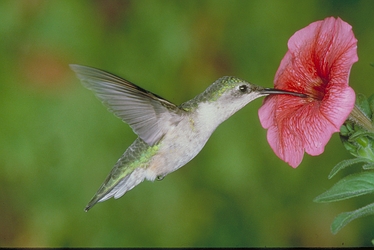
I love watching these birds as they come and pay me a visit. I am amazed as to how fast their wings go. I learned that the ruby throated hummingbirds are intensely inquisitive and are easily attracted to feeders, where males in particular typically display aggressive territoriality toward rival hummers, other birds, and even insects such as bees, butterflies, and sphinx moths. They quickly become accustomed to human presence, and will swoop down to investigate red articles of clothing, possibly as potential food sources.
The birds have visited my feeder from late July to October. They need an ample supply of insects and nectar for food. Tree are needed for nesting, resting and escape. They have a high metabolism. They can fly about 27 miles per hour and their wings beat 53 times per second.

I have several different types of flowers in my yard that has attracted these beautifu birds. I've seen them on my petunias, morning glory, columbine, lilies, and beard tongue.
A good guideline of when to stop feeding hummingbirds is to leave your hummingbird feeder up for about 2 weeks after your hummingbirds have left for the season. This will provide nectar for any hummingbirds that might have gotten a late start on their southward migration due to illness, injury or other reasons.
If you go 2 weeks without seeing a hummingbird in September or October, when hummingbird migration occurs across most of the United States, this might be when to stop feeding hummingbirds and take down your feeder until next year.
As the days get shorter, this decrease in the amount of daylight will trigger hormonal changes in the hummingbird that will cause them to migrate southward. So leaving your feeder up longer at the end of the season will not cause them to hang around longer than they should.
Now you should have a good idea of when to take down your hummingbird feeder and when to stop feeding hummingbirds.
No comments:
Post a Comment